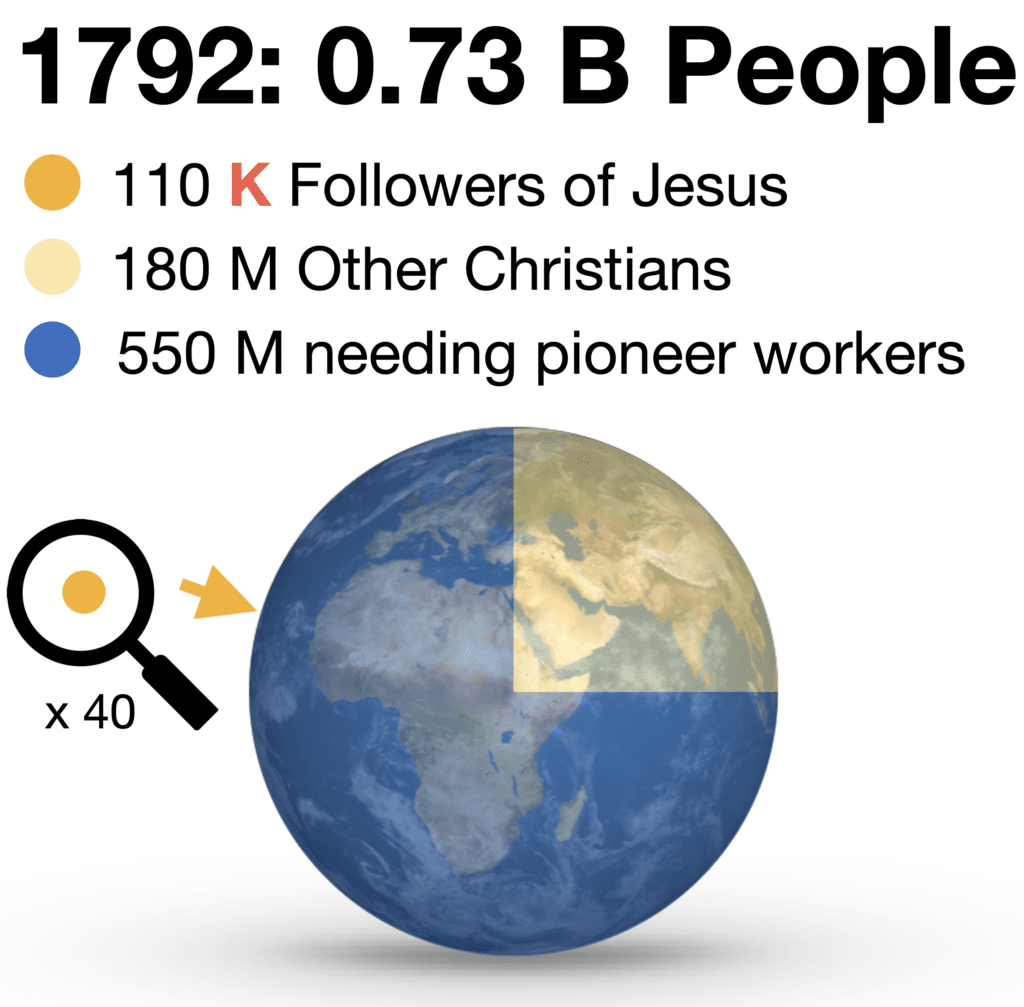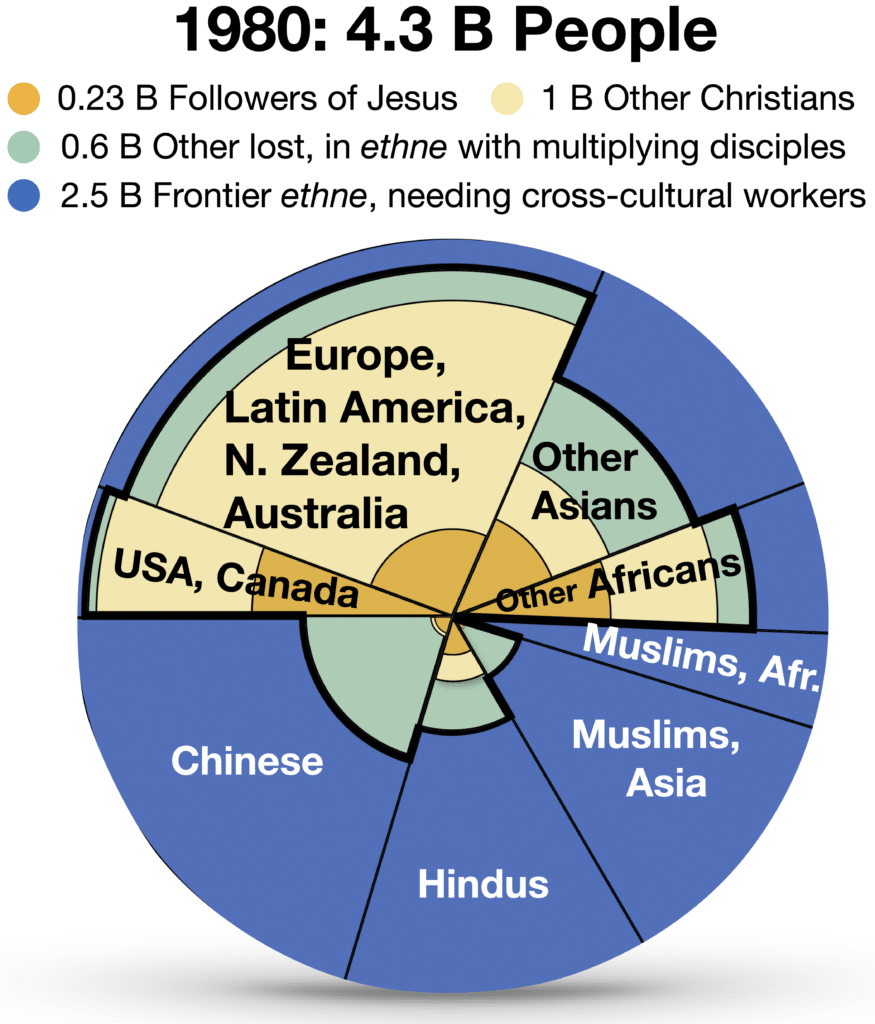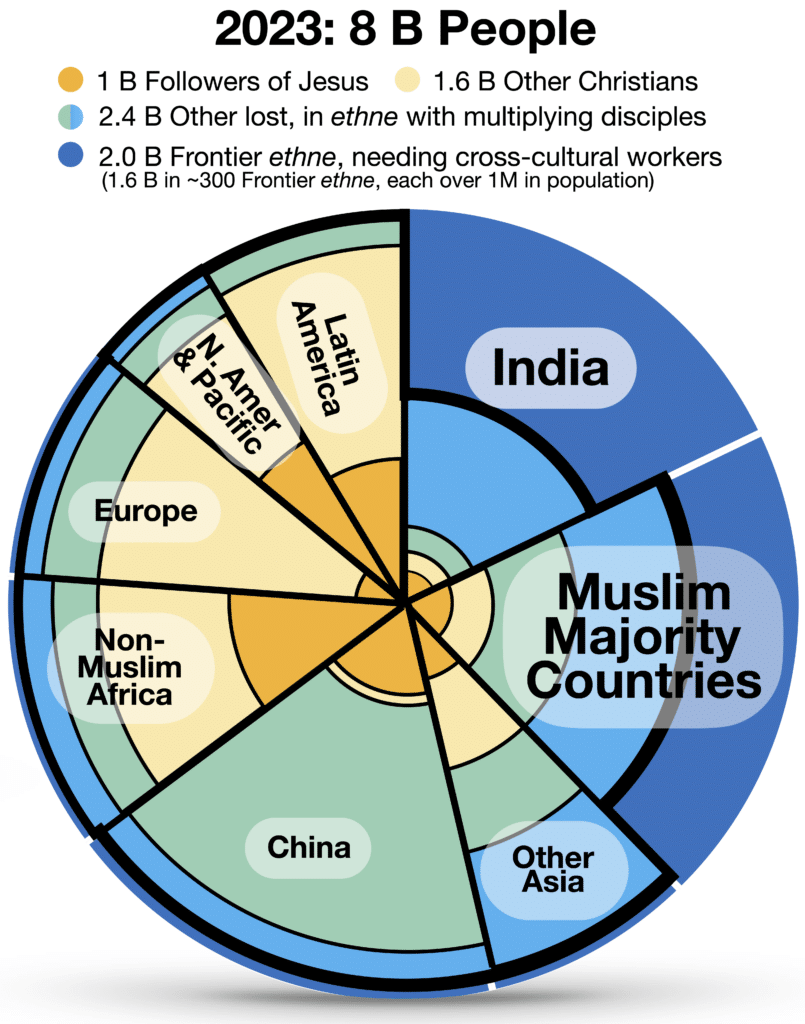Technology is Multiplying Prayer for ALL Nations

EMQ » July–September 2023 » Volume 59 Issue 3

Summary: An unprecedented number of people across the world are participating in coordinated 24/7/365 prayer for the fulfillment of God’s promise to bless all ethne. Advances in technology are fueling this prayer and linking believers together in prayer as never before.
By Elizabeth Adleta, Susmitha Kothari, Ray Peng, Pastor X*, Robby Butler
Spirit-led prayer has always, through God’s power, reached far enough to move the world. Yet specific prayer for the ethne (nations) Jesus commissioned us to disciple has long been limited by gaps in our awareness and vision. Today, advances in technology are helping fill these gaps – providing increasing clarity, and the ability to communicate that clarity widely.
This in turn is fueling prayer and linking believers in prayer as never before, in coordinated 24/7/365 prayer for the fulfillment of God’s promise to bless all the ethne – the family-lines and nations of earth – which Jesus commissioned us to disciple (Matthew 28:18–20).
With the Holy Spirit’s guidance, technology is enhancing what we pray about, how we pray, and with whom we pray.
Technology Helps us Grasp what God is Doing
Technology informs our prayers with awareness of what remains to be done, how fast we are making progress, and how rapidly followers of Jesus are multiplying.
Consider the ratio of (a) followers of Jesus, to (b) the global population isolated from the gospel within tight-knit ethne. At Pentecost this ratio was about one to two million. Today that same ratio is roughly one to two!
Here are the data points:
- Shortly after Jesus gave the Great Commission, around 33 AD, the Holy Spirit filled and empowered his first 120 followers. None of them understood the scope of this assignment. However, the world population then is now estimated at about 240 million. We can now estimate there was roughly one follower of Jesus for every two million people isolated from the gospel (in other ethne).

Nearly 18 centuries later, in 1792, William Carey published an assessment of the remaining missionary task in his day.i He estimated 75% (550 million) of the world’s 730 million people were in lands isolated from the gospel. If we generously estimate 110,000 followers of Jesus in the wake of the Moravian and Wesleyan revivals and other renewal movements of that day, that’s roughly one follower of Jesus for every 5,000 people isolated from the gospel. Carey then used the technology of his day (print) to appeal for dedicated teams to go to the nations, igniting a new wave of prayer to undergird the first proliferation of mission agencies.

Nearly two centuries later, Dr. Ralph Winter presented an updated assessment of the remaining missionary task. As of 1980ii followers of Jesus had multiplied to 0.25 billion, while 60% of humanity (2.5 billion) remained in ethne that were isolated from existing movements to Jesus by barriers of understanding or acceptance. In other words, there was then roughly one follower of Jesus for every ten people isolated from the gospel in ethne needing pioneer workers.
New technologies carried Winter’s assessment to followers of Jesus around the globe, fueling a dramatic multiplication of prayer and workers focused on bringing God’s blessing to the remaining ethne. Many former mission fields became mission prayer and sending bases as a result. In a recent issue of Mission Frontiers, John Robb details one of the thousands of ways the Lord answered such prayers.iii Robb concludes by inviting readers to adopt the remaining isolated ethne for prayer. Others have written similar summaries of the impact of these prayers for the remaining ethne.iv

Since Winter’s 1980 estimate, followers of Jesus have multiplied four-fold, to roughly one billion. And today only 25% of humanity (2 billion) remains isolated in tight-knit ethne – in the subset of Unreached People Groups (UPGs) now labeled Frontier People Groups (FPGs). Today there is roughly one follower of Jesus for every two people isolated from the gospel.

Practical Ways Technology is Enhancing Prayer
- Enhanced Engagement with Scripture
Scripture is the foundation for effectual, fervent prayer. Yet until recently Scripture was often limited to those who could read, who could afford a Bible, and for whom a good translation was available in their language. And even for these privileged few, becoming familiar with God’s purpose, promises, and provision was often a slow process.
Today, electronic and audio Scripture resources are much more abundant. Bibles, commentaries, concordances, and other reference materials in a variety of media formats are rapidly extending access to and understanding of Scripture to a much wider body of believers.
- Instant Awareness
Jesus told us to expect birth pains before the end – wars, famines, earthquakes, etc. However, until recently, significant delays existed between when such events occurred and when believers would be alerted to pray. Now we can pray within minutes for a crisis unfolding halfway around the world. Some even receive first-hand updates directly from friends affected by or helping with the disaster. Prayer can then be informed by videos, photos and texts, and news reports can provide a variety of global perspectives.
- Timely Field Updates
Missionaries and their supporters used to wait for a rare letter, or a visit from their missionaries to provide verbal reports and show photo albums and slideshows of their work. Text, audio, video, and images can now be transmitted instantly to supporters. This enables a real-time connection between missionaries and their supporters, and provides fuel for prayer, and for rejoicing over answered prayer.
- Reduced Barriers to Uniting in Prayer
Prayer has always given God’s children instant access to his throne of grace. Yet communication between his children was long limited by geographic and chronological distances.
Now prayer groups in a sending base country can interact frequently with field teams – even face-to-face and in some difficult locations – to share fellowship, pray for each other’s needs, and intercede for movements to Jesus in the people group the team is working among.
Believers around the world can now meet virtually to seek God for a movement among a particular people group, and record their prayers for others to later listen and agree with. And multiple prayer groups committed to a common people group can now share resources, news, and requests with each other, and meet together in prayer!
- Specific, Timely, Informed Prayer
When international communication was limited to postal mail, intercessors often had to rely on generalized and sometimes outdated requests for God’s intervention. With the acquisition of the right equipment, free communication now facilitates immediate, informed, and specific prayer. For example, since the war in Ukraine began in 2022, believers worldwide have received daily prayer updates from fellow believers experiencing the war first-hand. The same is happening now, in 2023, through the earthquake recovery in Turkey, and violence in Israel.
Clarity Stimulates Prayer
One of our enemy’s goals is to distract believers from taking the good news of Jesus to the 25% of humanity where the gospel has yet to take root. One way he does so is to keep believers focused solely on nurturing the seed of the gospel where it has already taken root – strengthening the Church where movements to Jesus are still small, and followers of Jesus are few and often persecuted.
Nurturing new believers and movements is essential, but we must not let this hinder focus on FPGs still needing pioneer workers. Technology is helping develop the essential clarity to spread awareness and ignite additional prayer for the FPGs still waiting for the light of Christ to dawn among them.
From Western-led to Global Initiative
Historically, Western initiatives like Joshua Project (joshuaproject.net) have led the way in utilizing technology to clarify and enlist prayer for those ethne still needing cross-cultural workers. And Western-based prayer has undergirded sending workers primarily from the West.

However, this has changed dramatically as non-Western believers have multiplied to several times the number of Western believers, often with much greater zeal to pray and share their faith. Hundreds of Indonesian prayer groups have been among the first globally to each adopt one of the ~300 FPGs with over 1 million in population (These ~300 FPGs contain 20% of humanity, and 80% of the total global population of FPGs).
Today technology to spread awareness and enlist prayer is also being utilized in former mission fields, including:
- BlessFrontierPeoples.org by Albanian believers.
- Pray1040.com/frontier-people-groups by a worker in southeast Asia.
- Pray4Movement.org by workers in North Africa.
- Cross-Roads.org/mp-intro.php by Chinese believers.
Strengthened and Deepened Relationships
Covid lockdowns accelerated a shift from face-to-face to video calls, digital conferencing, and hybrid meetings. This led many to meet virtually for prayer and Bible studies, regardless of their physical location and circumstances.
There is no age constraint on prayer. Around the world, Gen X’ers, Millennials, Gen Zs, Baby Boomers, and children are all praying together in unity, both in-person and virtually. Virtual meetings have also opened participation to the handicapped and housebound.
Technology is thus expanding who we pray with and strengthening relationships and birthing new models for collaboration. One example is the Storehouse movement from Newbreed.co (newbreed.co/storehouse/) which networks together “local and regional Christian community in order to facilitate economic relationships in biblical truth.”v
Yet virtual communities can create a false sense of knowing each other without really understanding one another’s context. And this can lead some to misunderstand the appropriate level of confidentiality for prayer requests and praise reports. Technology is also making it possible for Spirit-empowered believers to engage directly with individuals among FPGs, through both electronic communication and translation support for face-to-face contact.
Trust can also become more difficult to develop with both the lost and fellow believers where long-term contact is being replaced with brief encounters, and customary patterns of social connection and interaction are unavailable, such as eating or drinking tea or coffee together. Trust can also be difficult to build – and easily lost – where people from different cultures have competing values regarding security, confidentiality, etc.
Potential Downsides of Technology
Technology isn’t all positive. It can also tempt believers to become:
- More reliant on our technology than on God.
- Distracted from God and his unchanging purpose.
- Enslaved to fleshly desires.
Furthermore, the prince of the power of the air is stirring the aggressive use of technology to promote false negative impressions of Christianity – in our own societies and among the ethne still isolated from the gospel. Technology can make it difficult to discern truth from lies – deep fakes can strongly sway opinions.
Technology can also multiply our awareness of opportunities many times faster than our potential to absorb and respond to them. If we lose sight of Jesus, we can sink beneath these waves. If we stop yielding to the Holy Spirit, we may turn for short-term relief to mindless entertainment, or worse.
In the long-term, the expanded opportunities and information made available by technology can lead to burnout, compassion fatigue, and escapism. We must heed Jesus’ words in Gethsemane: “Pray so that you will not fall into temptation. The spirit is willing, but the flesh is weak” (Matthew 26:41; Mark 14:38; cf. Luke 22:40, 46).
Even with our eyes on Jesus and yielded to the Holy Spirit, technology can reinforce our blind spots through confirmation bias (ignoring data that contradicts our preconceptions). One such blind spot is the widespread assumption that everyone has similar access to the internet and related technologies. Interaction with well-resourced global leaders can reinforce this impression. Some have thus wrongly concluded that the gospel is now available through the internet to anyone with an honest and open heart, and that cross-cultural workers are no longer needed to incarnate the gospel.
But access to technology is distributed very unevenly around the world. Often modern technology is virtually nonexistent among the poorer and more oppressed ethne living in isolation from any Jesus movement. Furthermore, most websites can only be navigated in English and perhaps a few other major languages, leaving roughly one third of the world still without internet access.
Another threat hidden in technology is the ease with which believers can accidentally leak detailed, sensitive information. This increases the risk to local believers from hostile governments or religious fanatics. However, significant use of secure communications can also be like a smoke signal, drawing attention from hostile entities.
Encryption can help hide sensitive information, but the security risk created by just communicating with local believers or workers in hostile situations is often overlooked. When governments track communications, encrypted communication over a network of relationships can contribute to large-scale initiatives to shut down whatever is going on. In recent years, two large Asian governments demonstrated their ability and readiness to expel foreign workers and persecute the locals those workers associated with.
A more subtle danger with technology is becoming more preoccupied with protecting our security and extracting believers from difficult situations than with trusting and glorifying Jesus and encouraging disciples to remain bold during hardship. At the end of John, we find the disciples meeting twice with the doors locked for fear of the Jews (John 20:19, 26). Yet once these disciples were empowered by the Spirit, they demonstrated such remarkable boldness that even their persecutors were amazed (Acts 4:13).
Guided, Enhanced, and Collaborative Missional Prayer
Whether alone or with others, a variety of sites and technologies are available to enhance prayer for peoples isolated in places and cultures we would have difficulty imagining:
- PrayerCast.com offers free, beautiful videos to inform and stimulate prayer.
- AqueductProject.org/prayer-room-neapolis offers a virtual reality prayer experience – with or without a VR headset.
- Globalfamily24-7prayer.org provides a 24/7/365 virtual prayer community which offers visitors the opportunity to pray with others in a shared language and for common concerns.
- 110Cities.com offers guidance in praying for 110 Global Cities containing representatives of 80% of the world’s least evangelized people groups.
- DiscipleKeys.world follows this 110 Cities Initiative with weekly prayer points based on 52 key biblical principles of disciple-making movements and includes prayer daily for FPGs.
- JoshuaProject.net/pray/unreachedoftheday unites believers globally in praying for FPGs and other UPGs, with profiles for each group, a daily podcast and prayer reminder published on many websites, and reminder emails.
- Cross-Roads.org/mp-intro.php provides, in traditional Chinese and Cantonese, prayer resources similar to Joshua Project’s Unreached of the Day.
- MissionFrontiers.org publishes fresh prayer fuel every two months for FPGs and other UPGs, along with the current count of known movements to Jesus.
- BlessFrontierPeoples.org publishes an app and website with daily prayer guidance for the 31 largest FPGs, totaling nearly one billion people.
- JoshuaProject.net/frontier#podcast provides links to podcast recordings of the prayer guide for the 31 largest FPGs.
- Go31.org/FREE provides the printed prayer guide for the largest 31 FPGs along with resources to support those wanting to enlist others in prayer for FPGs.
- Indigitous.us/home/frontier-peoples has published a beautiful print/PDF introduction to FPGs for children, supported by a dramatized podcast edition.
- Pray1040.com/frontier-people-groups provides informative weekly email prompts to pray for FPGs.
- Prayfortech.com offers guidance in praying for believers and companies shaping the use of existing and emerging technology.
- PrayerStrategists.net provides a forum for relationships among those serving movements, organizations and networks to catalyze, mobilize, train and facilitate extraordinary prayer.
- Pray4Movement.org enlists and equips believers anywhere to lead others in praying for a movement to Jesus among a specific ethne or region.
- Ergatas.org provides linked technology to match those interested in praying for and supporting workers with workers that fit their interests.
- GetInvolved.com provides a new platform for prayer and collaboration around specific people groups.
- Connect.GGCN.org provides a more secure environment for prayer needs and collaboration exclusively among believers focused on pursuing movements among FPGs and other UPGs.
As we close in on completing Jesus’ Great Commission, new technology and collaboration are increasing accessibility to Scripture, providing prompt prayer fuel and updates from harvest workers, and refining our understanding of where pioneer cross-cultural witness is still most needed – among FPGs.
New technologies facilitate the multiplication of Jesus followers among 75% of the world and help to focus prayer on the remaining ethne Jesus commissioned us to disciple. In particular, 24/7 Zoom prayer rooms facilitate collaborative global prayer, and could rapidly develop strategically to extend 24/7 prayer for harvest workers, and for movements among each of the roughly 300 largest FPGs – encompassing 80% of those most isolated from the gospel.
Over decades or even centuries of engagement, many of these 300 largest FPGs have become resistant to traditional mission methods. Yet God’s sure promise to Abraham that these ethne will be blessed reinforces Jesus’ assurance that the gates of hell cannot keep his ecclesia from multiplying through them. Prayer, leading to Spirit-led collaboration, is essential to the fulfillment of God’s promise for these peoples.
Come join us in prayer at GlobalFamily24-7Prayer.org.

Elizabeth (Liz) Adleta (asianrd@gomail.asia) serves Jesus among the 40% of the world with least access to the gospel through prayer, tools, teamwork, training, and community transformation. Prayer is the indispensable key to this unfinished task. She leads the Fellowship of Prayer Strategists PrayerStrategists.net.

Susmitha (Susie) Kothari (susie@prayfortech.com) is first and foremost a follower and lover of Jesus and totally in awe of him. Her heart is to be a watchman on the wall for the tech industry and see his kingdom come in this industry that impacts almost everyone in the world. She is a software professional in the tech industry, and a member of the core leadership team for PrayForTech.com.

Ray Peng (pray.go@gmail.com) is founder of the We initiative. Involved in mission mobilization for over a decade, he is associated with Via Global and has served in leadership roles with UMOT, CCCoWE, and the Global Mobilization Network. He is the author of four books and is currently based in Taipei.

Pastor X* is a Western man married to a former radical Muslim. Together they disciple believers in the Middle East. They are witnesses to, and part of, the underground church of the East that sparked the fastest movement of Christianity in the world – and it’s coming to America. Are we ready? If you have not yet viewed the feature film, “Sheep Among Wolves, Vol. 2” we encourage you to watch it: youtu.be/9SAPOLKF59U.

Robby Butler (RobbyQButler@pm.me) studied programming at Caltech before serving for 24 years with the U.S. Center for World Mission – first in the computer department and later as Ralph Winter’s personal assistant. In 2004, he and his wife Jackie founded Mission Network to support other ministries and individual ministries in pursuing their calling and vision for impacting those ethne still without movements to Jesus.
EMQ, Volume 59, Issue 3. Copyright © 2023 by Missio Nexus. All rights reserved. Not to be reproduced or copied in any form without written permission from Missio Nexus. Email: EMQ@MissioNexus.org.




Responses